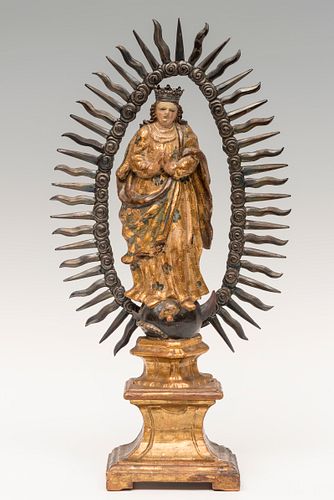Purisima; Andalusian school; century XVIII. Carved wood, gilded, polychrome and silver.
Lot 5
About Seller
Setdart Auction House
Carrer Aragó 346
Barcelona
Spain
Setdart Subastas was born in 2004 and is currently the first online art auction in Spain with solidity, prestige and reliability guaranteed by our more than 60,000 users. Setdart has a young, dynamic and enterprising team ready to successfully manage the purchase and sale of art works through custom...Read more
Categories
Estimate:
EUR€1,200 - EUR€1,500
$1,250 - $1,562.50
Absentee vs Live bid
Two ways to bid:
- Leave a max absentee bid and the platform will bid on your behalf up to your maximum bid during the live auction.
- Bid live during the auction and your bids will be submitted real-time to the auctioneer.
Bid Increments
| Price | Bid Increment |
|---|---|
| EUR€0 | EUR€10 |
| EUR€200 | EUR€25 |
| EUR€500 | EUR€50 |
| EUR€1,000 | EUR€100 |
| EUR€3,000 | EUR€200 |
| EUR€5,000 | EUR€500 |
| EUR€10,000 | EUR€1,000 |
| EUR€20,000 | EUR€2,000 |
| EUR€50,000 | EUR€5,000 |
About Auction
By Setdart Auction House
Jun 1, 2021
Set Reminder
2021-06-01 09:45:00
2021-06-01 09:45:00
America/New_York
Bidsquare
Bidsquare : OLD MASTERS & SCULPTURE - Day 2
https://www.bidsquare.com/auctions/setdart-auction-house/old-masters-sculpture---day-2-6999
Setdart Auction House sofia@setdart.com
Setdart Auction House sofia@setdart.com
- Lot Description
Purisima; Andalusian school; century XVIII. Carved wood, gilded, polychrome and silver. Measures: 43 x 23 x 11.5 cm. The representation of the Immaculate Conception is an invocation based on an evolved iconographic concept, which sometimes associates the theme of the Coronation of the Virgin or the Immaculate Conception. The latter is the most recurrent iconographic pattern, in which Mary appears standing, dressed in a white tunic and blue mantle, with her hands crossed on her chest, with the moon at her feet and stepping on the infernal serpent, which in this painting is slightly outlined, symbol of her victory over Original Sin. Most of these images are accompanied, in the painting, by the Marian symbols of the litanies and psalms, such as the mystical rose, the palm tree, the cypress, the closed orchard, the ark of Faith, the door of Heaven, the ivory tower, the sun and the moon, the sealed fountain, the cedar of Lebanon, the mirror without stain, the morning star, etc. Seventeenth-century artists faithfully maintained the iconographic type but dispensed with or reduced the symbols of the litanies, incorporating them into the composition in a naturalistic manner, and sought a greater dynamism and sense of theatricality. This tendency will culminate in the 18th century, when we find compositions like the one we present here, with Mary surrounded by angels, still with some iconographic attributes but already very reduced. Given the importance given to religious images in the Hispanic world, during the 17th and 18th centuries ambitious pictorial series and extensive iconographic programs were created for churches and convents, as well as printed prints, medals and reliquaries for private devotion. As a whole, regardless of their size or support, these images fulfilled the objective of sacralizing daily life beyond the altars. The Granada school stood out during this period, receiving and developing the stylistic patterns of the Baroque.
- Shipping Info
-
In-house shipping available. Please inquire at admin@setdart.com.
-
- Buyer's Premium



 EUR
EUR CAD
CAD AUD
AUD GBP
GBP MXN
MXN HKD
HKD CNY
CNY MYR
MYR SEK
SEK SGD
SGD CHF
CHF THB
THB

















